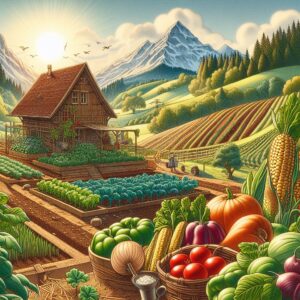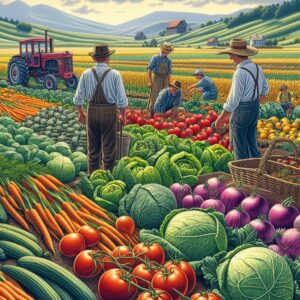Comprehensive Guide to Vegetable Farming in Europe
Vegetable farming is a vital part of European agriculture, contributing significantly to the region’s economy, food security, and cultural heritage. This comprehensive guide covers various aspects of vegetable farming in Europe, including the types of vegetables grown, farming practices, economic and environmental considerations, and practical tips for successful vegetable farming.
Overview of Vegetable Farming in Europe
Importance of Vegetable Farming
- Economic Contribution: Vegetable farming is a key sector in European agriculture, providing employment and income for millions of farmers.
- Food Security: Vegetables are essential for a balanced diet, contributing to food security and nutrition.
- Cultural Heritage: Many European countries have rich traditions and regional specialties related to vegetable farming.
Types of Vegetables Grown in Europe
- Root Vegetables: Carrots, potatoes, beets, and parsnips.
- Leafy Greens: Lettuce, spinach, kale, and chard.
- Cruciferous Vegetables: Cabbage, broccoli, cauliflower, and Brussels sprouts.
- Fruiting Vegetables: Tomatoes, peppers, cucumbers, and eggplants.
- Legumes: Peas, beans, and lentils.
- Alliums: Onions, garlic, leeks, and shallots.
Key Vegetable Farming Regions
- Spain: Known for its extensive production of tomatoes, peppers, and cucumbers.
- Italy: Renowned for its diverse vegetable production, including tomatoes, artichokes, and leafy greens.
- Netherlands: A leader in greenhouse vegetable production, especially tomatoes, cucumbers, and peppers.
- France: Famous for its diverse vegetable farms producing carrots, leeks, and lettuce.
- Poland: Significant producer of cabbage, onions, and carrots.
Farming Practices in Vegetable Production
Soil Preparation
- Soil Testing: Conduct soil tests to determine nutrient levels, pH, and soil structure. Adjust soil amendments accordingly.
- Tillage: Use appropriate tillage methods to prepare the soil, ensuring good tilth and aeration. Avoid excessive tillage to prevent soil erosion.
- Organic Matter Addition: Incorporate compost, manure, and green manures to improve soil fertility and structure.
Planting
- Seed Selection: Choose high-quality seeds suited to the local climate and soil conditions. Consider disease-resistant varieties.
- Planting Methods: Use direct seeding or transplanting methods based on the type of vegetable and growing conditions.
- Spacing: Ensure proper spacing between plants to reduce competition for nutrients and light, and to minimize disease spread.
Irrigation
- Efficient Irrigation Systems: Implement drip irrigation or micro-sprinklers to deliver water directly to the root zone, reducing water waste.
- Scheduling: Adjust irrigation schedules based on crop needs, soil moisture levels, and weather conditions.
- Water Conservation: Use mulching and cover cropping to retain soil moisture and reduce evaporation.
Fertilization
- Organic Fertilizers: Use compost, manure, and other organic fertilizers to provide essential nutrients and improve soil health.
- Balanced Nutrient Management: Apply fertilizers based on soil test results and crop requirements to avoid over-fertilization and nutrient runoff.
- Foliar Feeding: Use foliar sprays to address specific nutrient deficiencies during the growing season.
Pest and Disease Management
- Integrated Pest Management (IPM): Implement IPM strategies, including cultural, biological, mechanical, and chemical controls, to manage pests and diseases.
- Crop Rotation: Rotate crops to break pest and disease cycles and improve soil health.
- Resistant Varieties: Plant disease-resistant varieties to reduce the incidence of crop diseases.
Harvesting
- Timing: Harvest vegetables at the optimal stage of maturity to ensure the best quality and flavor.
- Handling: Use proper handling techniques to minimize damage and post-harvest losses.
- Storage: Store harvested vegetables under appropriate conditions to maintain freshness and extend shelf life.
Economic Considerations
Market Trends
- Consumer Demand: Increasing demand for fresh, organic, and locally grown vegetables.
- Export Opportunities: Expanding markets for European vegetables, particularly in neighboring countries and regions.
- Value-Added Products: Growing interest in value-added vegetable products such as pre-cut, packaged, and processed vegetables.
Financial Management
- Cost Analysis: Perform detailed cost analysis to understand production costs and identify areas for cost savings.
- Budgeting: Create and maintain a budget to manage expenses and plan for investments.
- Diversification: Diversify crops and income streams to reduce financial risk and increase profitability.
Access to Funding
- Government Grants and Subsidies: Explore available government grants and subsidies for vegetable farming, particularly those focused on sustainability and innovation.
- Bank Loans and Credit: Secure financing from agricultural banks and credit unions for capital investments and operational expenses.
- Crowdfunding and Investment: Consider alternative funding sources such as crowdfunding and private investment for innovative projects and expansions.
Environmental Considerations
Sustainable Farming Practices
- Soil Health: Prioritize soil health through practices like crop rotation, cover cropping, and reduced tillage.
- Water Conservation: Implement water-saving techniques such as efficient irrigation systems, rainwater harvesting, and mulching.
- Biodiversity Enhancement: Promote biodiversity through agroforestry, polyculture, and wildlife conservation practices.
Climate Change Adaptation
- Climate-Resilient Varieties: Plant climate-resilient vegetable varieties that can withstand extreme weather conditions.
- Water Management: Improve water management practices to cope with changing precipitation patterns and increased water scarcity.
- Carbon Sequestration: Enhance carbon sequestration through practices like cover cropping, reduced tillage, and organic matter addition.
Environmental Impact
- Chemical Use Reduction: Minimize the use of synthetic fertilizers and pesticides to reduce environmental pollution.
- Energy Efficiency: Implement energy-efficient practices and renewable energy sources to reduce carbon footprint.
- Waste Management: Develop waste management plans to recycle and reuse agricultural waste, reducing overall waste generation.
Practical Tips for Successful Vegetable Farming
Soil Health Management
- Regular Soil Testing: Conduct regular soil tests to monitor soil fertility and pH levels, and adjust management practices accordingly.
- Composting: Apply compost to improve soil fertility and structure, and increase organic matter content.
- Cover Cropping: Plant cover crops to protect soil from erosion, improve soil organic matter, and suppress weeds.
- Reduced Tillage: Minimize soil disturbance to maintain soil structure, reduce erosion, and enhance microbial activity.
Water Management
- Efficient Irrigation: Use efficient irrigation systems like drip or micro-sprinklers to reduce water use.
- Rainwater Harvesting: Collect and store rainwater for irrigation and other farm uses.
- Mulching: Apply mulch to retain soil moisture, reduce evaporation, and suppress weeds.
- Soil Moisture Monitoring: Use soil moisture sensors to optimize irrigation schedules and avoid overwatering.
Integrated Pest Management (IPM)
- Biological Controls: Use natural predators and beneficial insects to control pest populations.
- Cultural Practices: Implement crop rotation, intercropping, and resistant varieties to manage pests and diseases.
- Mechanical Controls: Use physical methods like traps, barriers, and hand-picking to reduce pest numbers.
- Chemical Controls: Apply pesticides as a last resort, using targeted applications to minimize environmental impact.
Crop Rotation and Diversification
- Plan Rotations: Develop a crop rotation plan that includes a variety of vegetables to improve soil health and reduce pest pressure.
- Diversify Crops: Grow a diverse range of vegetables to spread risk, meet market demand, and enhance biodiversity.
- Intercropping: Practice intercropping to maximize land use, improve soil fertility, and reduce pest and disease incidence.
Post-Harvest Handling and Storage
- Proper Handling: Handle vegetables carefully during harvesting to minimize bruising and damage.
- Cooling and Storage: Cool harvested vegetables quickly and store them under optimal conditions to extend shelf life and maintain quality.
- Packaging: Use appropriate packaging materials to protect vegetables during transport and display.
Case Studies and Examples
Case Study 1: Organic Vegetable Farming in Italy
Location: Tuscany, Italy
Practices:
- Organic Certification: Following organic certification standards to produce organic vegetables.
- Soil Health: Implementing practices like composting, cover cropping, and reduced tillage to maintain soil health.
- Water Management: Using efficient drip irrigation systems and rainwater harvesting to conserve water.
Outcomes: The farm has achieved high-quality organic vegetable production, improved soil health, and reduced environmental impact through sustainable practices.
Case Study 2: Greenhouse Vegetable Production in the Netherlands
Location: Flevoland, Netherlands
Practices:
- Controlled Environment: Utilizing greenhouse technology to control temperature, humidity, and light for optimal vegetable growth.
- Efficient Irrigation: Implementing precise drip irrigation systems to conserve water and reduce waste.
- Integrated Pest Management: Using biological controls and cultural practices to manage pests and diseases.
Outcomes: The greenhouse operation has achieved high yields, reduced water use, and minimized chemical inputs through advanced technology and sustainable practices.
Case Study 3: Community-Supported Agriculture (CSA) in France
Location: Provence, France
Practices:
- Direct-to-Consumer Sales: Operating a CSA program to provide fresh, locally grown vegetables directly to consumers.
- Crop Diversification: Growing a diverse range of vegetables to meet the needs of CSA members and enhance biodiversity.
- Community Engagement: Hosting farm events and workshops to educate and engage the local community.
Outcomes: The CSA program has built a loyal customer base, diversified income streams, and strengthened community ties through direct engagement and education.
Case Study 4: Regenerative Vegetable Farming in Spain
Location: Andalusia, Spain
Practices:
- Cover Cropping: Using cover crops to improve soil organic matter and prevent erosion.
- No-Till Farming: Adopting no-till practices to maintain soil structure and enhance microbial activity.
- Agroforestry: Integrating trees with vegetable crops to diversify income and improve biodiversity.
Outcomes: The farm has improved soil health, increased resilience to climate change, and enhanced biodiversity through regenerative practices.
Challenges and Solutions
Soil Degradation
Challenges:
- Erosion: Soil erosion caused by wind and water can degrade soil structure and reduce fertility.
- Compaction: Heavy machinery and intensive farming practices can lead to soil compaction, restricting root growth and water infiltration.
Solutions:
- Cover Cropping: Plant cover crops to protect soil from erosion and improve soil structure.
- Reduced Tillage: Minimize soil disturbance to prevent compaction and maintain soil health.
- Organic Matter Addition: Apply compost and organic mulches to improve soil structure and fertility.
Climate Change
Challenges:
- Extreme Weather: Increased frequency of extreme weather events, such as droughts and floods, can impact vegetable production.
- Temperature Fluctuations: Changes in temperature patterns can affect vegetable growth and yield.
Solutions:
- Water Conservation: Implement efficient irrigation systems and water conservation practices to manage water resources.
- Climate-Resilient Varieties: Plant climate-resilient vegetable varieties to withstand extreme weather conditions.
- Soil Resilience: Enhance soil resilience through practices like cover cropping, crop rotation, and organic matter addition.
Pest and Disease Management
Challenges:
- Pest Pressure: High pest pressure can reduce vegetable yields and quality.
- Disease Incidence: Diseases can spread quickly in vegetable crops, leading to significant losses.
Solutions:
- Integrated Pest Management (IPM): Implement IPM strategies to manage pests and diseases sustainably.
- Crop Rotation: Rotate crops to break pest and disease cycles and improve soil health.
- Resistant Varieties: Plant disease-resistant varieties to reduce the incidence of crop diseases.
Market Access
Challenges:
- Market Volatility: Fluctuating market demand and prices can impact profitability.
- Distribution Channels: Accessing and maintaining efficient distribution channels can be challenging, especially for small-scale farmers.
Solutions:
- Direct-to-Consumer Sales: Explore direct-to-consumer sales channels such as farmers’ markets, CSA programs, and online sales to increase profit margins.
- Branding and Promotion: Develop a strong brand identity and promote products through social media, farm tours, and participation in local events.
- Export Opportunities: Research and pursue export opportunities to expand market reach and increase sales.
Future Outlook for Vegetable Farming in Europe
Technological Advancements
- Precision Agriculture: Adoption of precision agriculture technologies such as GPS, sensors, and drones to improve efficiency and productivity.
- Smart Irrigation Systems: Implementation of smart irrigation systems that use real-time data to optimize water use.
- Artificial Intelligence: Use of AI-powered tools to analyze data and provide insights for improving crop management and yield.
Policy and Support
- Government Initiatives: European governments are implementing policies and support programs to promote sustainable vegetable farming practices.
- EU Green Deal: The European Green Deal aims to make Europe the first climate-neutral continent by 2050, with significant focus on sustainable agriculture.
- Funding Opportunities: Farmers can access funding opportunities through programs like the Common Agricultural Policy (CAP) and Horizon Europe for innovative and sustainable farming initiatives.
Research and Innovation
- Crop Research: Ongoing research focuses on developing new vegetable varieties that are more resilient to climate change and pests.
- Soil Health: Research into soil health and management practices to improve soil fertility and sustainability.
- Knowledge Exchange: Platforms for knowledge exchange and dissemination of best practices help farmers adopt innovative vegetable farming practices.
Sustainable Practices
- Regenerative Agriculture: Emphasis on regenerative agriculture practices that restore soil health, enhance biodiversity, and improve resilience to climate change.
- Organic Farming: Increasing adoption of organic farming practices that prioritize soil health and environmental sustainability.
- Agroecology: Integrating agroecological principles to create sustainable and resilient farming systems.
Conclusion
Vegetable farming in Europe is a dynamic and essential part of the agricultural sector, contributing to the economy, food security, and cultural heritage. By adopting comprehensive farming practices, sustainable strategies, and technological advancements, European vegetable farmers can enhance productivity, profitability, and environmental stewardship. This guide provides valuable insights, practical tips, and strategies for successful vegetable farming, ensuring a resilient and sustainable future for the industry. Through continued innovation, research, and collaboration, European farmers can lead the way in sustainable vegetable production and contribute to a healthier, more sustainable future for agriculture.
Vegetable Farming Gallery








